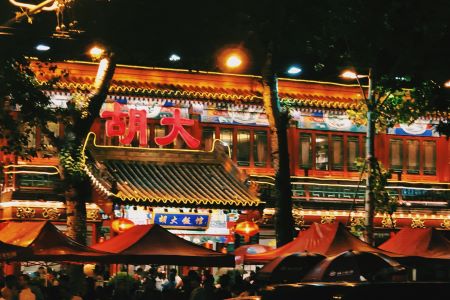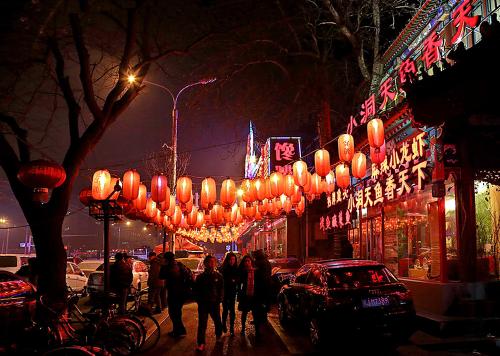Chinese Name: 簋街 Pronunciation: Guǐ Jiē
Length: 1,442 meters
Building Time: In the 1980s
Recommended Time for Visit: 1-2 Hours
Address: Dongzhimennei Street, Dongcheng District, Beijing, China
Building Function: A street for selling local foods and developing nighttime economy

The Chinese character, pronouncing Guǐ, means a round food container with two handles in ancient times, which indicates that Gui Jie is a good place to eat.
The layout of restaurants in Gui Jie is dumbbell-shaped, which implies that the most popular restaurants are at the east and west ends of the street, followed by those in the middle section.
There are many famous local foods in Beijing such as bittern flapjack, fried tripe, and lamb spine. In recent years, a food chain of spicy crayfish has sprung up in Gui Jie. Besides, hot pot style bullfrog and roast fish become the specialties here.
As Gui Jie is adjacent to many embassies, foreign tourists usually choose to come here to learn about Chinese food culture. In Gui Jie, you can often see many foreigners gathering at a table with several Chinese people and talking happily. In the middle of the table, there is a hot pot or a hot pot style roast fish wafting out an appetizing smell.
Here, foreigners’ eating habits can be assimilated by Chinese food because of the delicious taste. In this way, Chinese food is successfully introduced abroad. It is also the best place for Beijing local people to have a midnight snack.

A decade ago, there were only a few restaurants on this street. Because there would also be people coming here after 9 p.m., these restaurants extended the business hours. Later, they changed their business hour to 24 hours a day. Therefore, Gui Jie becomes a part of the night market culture in Beijing. It is not only a place for eating and drinking but also reflects the everyday life of Beijing people.
It is said that in Gui Jie, the price of a spicy crayfish is about three to eight yuan. If three or four people go there to eat, 40 spicy crayfish and another three to four dishes are enough, which cost about 150 to 350 yuan. That is to say, each people can enjoy a delicious meal while spending 50 to 90 yuan.

When it comes to the origin of Gui Jie, it can trace back to the 1980s. At the beginning of the reform and opening up, people only ate at public canteens of state-owned enterprises. There were no state-owned restaurants, let alone private ones.
A person called Li Xiaolin saw the bright future of Dongzhimen since embassies and a financial trading cluster area were going to be built there. Therefore, he established his private catering business—Xiaolin Restaurant. It was one of a few private restaurants inside Dongzhimen and the first restaurant that ran 24 hours a day.
It didn’t take long for other restaurants to open after the Xiaolin’s. When there were about ten restaurants, the street became a night market selling local food. As the fame of this street spread fast all over the country, people came here by bike, even by taxi to eat. Gui Jie was thus developed.
It is said that in the old times, vendors on the street sold groceries, vegetables, and fruits in the daytime. At night, they used kerosene lamps to provide light. The lamplight looked like the ghost shadow seen from a distance. Therefore, the street was called Gui Jie, literally meaning Ghost Street.
Spicy crayfish, hot pot style roast fish and bullfrog, Beijing roast duck, lamb spine, lamb tripe, bittern flapjack, etc.
Some of the restaurants are so popular that you need to wait in line for food. If you want to eat there, you can get a queue number and then go to other places nearby to kill the time.
The nighttime economy is prevailing in China, let alone the capital city Beijing, Therefore, it is recommended to visit Gui Jie after 18:00, and you may have a better experience of the passion of the Chinese people and the uniqueness of Chinese culture.
Gui Jie → Nanluoguxiang → Yandaixie Street → Shichahai → Beihai Park
If it is your first-time traveling in Beijing, please buy a bus card or download “Yitongxing” or “Beijing Yikatong” App on your mobile phone in advance for convenience. Both apps are available for buses and subway.
Take bus 24, 106, 107, 117, Night 6, or Night 10 and get off at Dongnei Xiaojie Station. And then walk westward for 70 meters along the Dongzhimen Neidajie, turn right, walk 10 meters and then go straight for about 40 meters to the destination.
Take bus 612, 63, 406, or Night 28 and get off at Dongzhimen Beixiaojie Nankou Station. After that, you need to walk southward about 120 meters along the Dongzhimen Beixiaojie, turn right, walk 10 meters and then go straight into Dongzhimen Neidajie, walk about 170 meters, turn right, walk 40 meters to the Gui Jie.
Take Metro Line 5 and get off at Beixinqiao Station (Exit C). And then you need to walk eastward for 300 meters along the Shique Hutong, turn left into the Xintaicang Hutong, walk about 80 meters, turn right into the Dongzhimen Neidajie, walk about 210 meters, turn left, walk 10 meters, go straight for 40 meters to the destination.
Chinese: 请带我去簋街。English: Please take me to Gui Jie.
If you go to Gui Jie from the center of Beijing (Grand Hyatt Beijing), it takes about 15 minutes (about 20 yuan).
If you go to Gui Jie from Beijing Capital International Airport, it takes about 30 minutes (about 60 yuan).
If you go to Gui Jie from Beijing Daxing International Airport, it takes about 1 hour (about 200 yuan).
If you go to Gui Jie from Beijing West Railway Station, it takes about 30 minutes (about 40 yuan).
If you go to Gui Jie from Beijing South Station, it takes about 30 minutes (about 40 yuan).
If you go to Gui Jie from Beijing Railway Station, it takes about 20 minutes (about 20 yuan).
